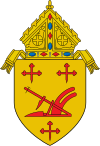Cathedral Basilica of St. Peter in Chains
St. Peter-In-Chains Cathedral | |
 St. Peter in Chains Cathedral in downtown Cincinnati | |
| Location | Cincinnati, Ohio |
|---|---|
| Coordinates | 39°6′13.89″N 84°31′8.70″W / 39.1038583°N 84.5190833°W |
| Architect | Henry Walter[1] Edward J. Schulte (renovation)[2] |
| Architectural style | Greek Revival[1] |
| NRHP reference No. | 73001469[1] |
| Added to NRHP | January 18, 1973[1] |
Saint Peter in Chains Cathedral is the cathedral of the Roman Catholic Archdiocese of Cincinnati.
Description
The cathedral is a Greek revival structure located at 8th and Plum Streets in downtown Cincinnati. St. Peter in Chains was begun with the laying of its cornerstone on 20 May 1841, under the direction of then-bishop—later archbishop—John Baptist Purcell, and formally dedicated on 2 November 1845. Its striking single spire, which rises 224 feet (68 m)[3] above street level, was the tallest man-made structure in the city for many decades, and is constructed of pure white limestone.
The first St. Peter's was located at Sixth and Sycamore Street, in Cincinnati, Ohio. It was dedicated on December 17, 1826 at what is now the site of St. Francis Xavier Church and became the seat of the First bishop. The large stone angels that were on each side of the main altar were created by Odoardo Fantacchiotti in the late 1840s.[4] They were among the first European sculptures to come to Cincinnati and now grace the Cincinnati Art Museum.[5][6]
The interior of St. Peter in Chains is distinctly unique among Roman Catholic cathedrals in America, with its Greek-themed mosaics depicting the Stations of the Cross, its ornate Corinthian columns and its massive bronze doors. The crucifix is by Benvenuto Cellini, the murals by Carl Zimmerman and the mosaic in the apse is the work of Anton Wendling.[2]

St. Peter in Chains was, from 1938 until 1957, replaced as Archdiocesan cathedral in favor of the more modern Saint Monica's in Clifton Heights neighborhood, north of downtown. Under Archbishop Karl Joseph Alter's urban-renewal program, St. Peter in Chains underwent significant restoration and expansion in the mid-1950s, and on 3 November 1957, amid much celebration and fanfare, was re-dedicated a cathedral.
In 1977, the cathedral hosted a visit from Polish Archbishop Karol Wojtyla, who the following year became Pope John Paul II. To date more than two-dozen Roman Catholic bishops have been consecrated within its walls, and the cathedral is a popular venue for weddings, as well as the annual ordination of the Archdiocese's priests and deacons.
See also
References
- ^ a b c d e "National Register Information System". National Register of Historic Places. National Park Service. June 30, 2007.
- ^ a b Dorsey, Robert W. Ed. (1987). Architecture and Construction in Cincinnati:Guide to Buildings, Designers & Builders. The Architectural Foundation of Cincinnati. p. 81.
- ^ Foster, Ellsworth D.; Hughes, James Laughlin (1922). The American Educator. Ralph Durham Company. p. 823.
- ^ Rolfes, Steven (October 29, 2012). "Cincinnati Landmarks". Arcadia Publishing. p. 25. Retrieved 2013-05-19.
- ^ "About the Collection: Praying Angel". Cincinnati Art Museum. Retrieved 2016-03-04.
- ^ "About the Collection: Adoring Angel". Cincinnati Art Museum. Retrieved 2016-03-04.



